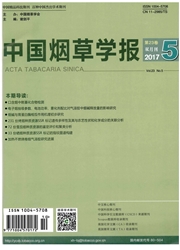

 中文摘要:
中文摘要:
以烤烟-水稻复种连作8年的土壤为研究对象,通过田间定位试验,研究冬闲、稻草回田、冬种紫云英回田等三种养地方式对烤烟根际微生态的影响。结果表明,(1)土壤化感自毒潜力以冬闲养地方式烤烟根际土壤自毒作用最强,其次是冬种紫云英,稻草回田自毒作用最小。(2)基于 BIOLOG平板法的微生物功能多样性研究表明,冬闲利于以糖类、酚酸类物质为碳源的微生物生长;稻草回田利于以胺类为碳源的微生物生长;冬种紫云英回田利于以羧酸类、脂肪酸、氨基酸类为碳源的微生物生长。(3)土壤微生物利用碳源的多样性指数:SIMPSON(J)指数、SHANNON(H)指数、SHANNON(HE)均匀度指数、BRILLOUIN指数、McIntosh(Dmc)指数,均稻草回田处理高于冬闲和冬种紫云英,说明稻草回田最有利于改善烤烟根际土壤微生物多样性。可见,对改善土壤微生物群落多样性,减少连作土壤的自毒作用,稻草回田最好,其次是紫云英回田,冬闲最差。
 英文摘要:
英文摘要:
Rhizospheric soil samples from tobacco-rice grow consecutively for 8 years were used to investigate the effect of different soil management methods on tobacco rhizosphere micro ecology. These methods include fallow, straw return to field and winter vetch breeding. Results showed that monoculture soil treated with traditional fallow had the largest autotoxic allelopathic potential while soil treated with straw return to field had the smallest. BIOLOG analysis showed that traditional fallow in winter was conducive to growth of microbial flora feeding on carbohydrate and phenolic acid as carbon sources. Rice straw return to field was favorable to growth of microbial flora using amines as carbon source, and winter vetch breeding was good for growth of microbial flora feeding on carbohydrate, fatty acids, and phenolic acids as carbon sources. Diversity indices of microbes utilization of carbon sources suggested that microbial diversity, such as SIMPSON, SHANNON, EVENNESS, BRILLOUIN, McIntosh indices, in rhizospheric soil of flue-cured tobacco were robust under the treatment of rice straw return to field. As for improving growth of microbial flora in continuous cropping soil, rice straw return to field treatment was favorable to malntaln rhizospheric soil nutrient equilibrium and to ameliorate the stability of soil micro-ecological system. Vetch breeding return to field showed medium effect, and traditional fallow had the lowest effect.
 同期刊论文项目
同期刊论文项目
 同项目期刊论文
同项目期刊论文
 期刊信息
期刊信息
